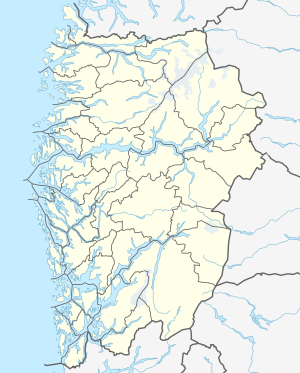Hardangerbrua
Coordinates: 60 ° 28 ′ 46 " N , 6 ° 49 ′ 53" E
| Hardangerbrua | ||
|---|---|---|
| Hardangerbrua shortly before the opening (August 2013) | ||
| Official name | Hardangerbrua | |
| use | Riksvei 7, Fylkesvei 7, Riksvei 13 | |
| Crossing of | Hardangerfjord | |
| place | Brimnes ( Eidfjord ) and Bruravik ( Ulvik ) in Fylke Vestland | |
| construction | Suspension bridge | |
| overall length | 1380 m | |
| height | 202 m | |
| Clear height | 55 m | |
| building-costs | expected to be 2.3 billion Norwegian kroner | |
| start of building | February 26, 2009 | |
| completion | 17th August 2013 | |
| planner | Statens vegvesen (client) | |
| toll | 150 Norwegian kroner | |
| location | ||
|
|
||
The Hardangerbrua ( German Hardanger Bridge ) is a suspension bridge over the Eidfjord in Norway .
meaning
The bridge replaces the ferry connection between Brimnes and Bruravik and is part of Riksveier or Fylkesveier 7 and 13. The latter is an important north-south connection between the Sognefjord region and Stavanger , the former is the shortest connection between Oslo and Bergen - but it is the main connection is the European route 16 , as it does not run over the Hardangervidda and is therefore safe for winter, but 70 km longer.
Previously ferries ran every 20 to 60 minutes; the crossing took 10 minutes.
Dimensions
The bridge has a total length of 1,380 m and a clearance height of 55 m. Due to the great depth of the Hardangerfjord (up to 500 m near the bridge), the 202.5 m high pylons have to be on land, so the bridge has a span of 1,310 m and was the longest bridge in Norway and 10th worldwide when it opened. The Hardangerfjord is deep enough for all ships, but because of the clear height of the bridge, large cruise ships can no longer sail into the inner Hardangerfjord.
The bridge has two lanes with a total width of 7.5 m and a foot / bicycle path. At both ends, the bridge leads directly into tunnels, in which the traffic routes connected to the bridge are separated again by roundabouts .
15,000 tons of steel were used, almost half of which was used for the suspension ropes and the rest for the track box. In addition, 22,400 cubic meters of concrete were used, 13,000 cubic meters of which in the pylons , the rest in the anchors and tunnel portals.
Construction and Financing
Construction began on February 26, 2009. On October 7, 2009, construction of the pylons began; they were completed in May 2011. On November 6, 2011, air-spinning of the suspension cables began. On August 17, 2013, the bridge was opened to traffic as scheduled.
The bridge was built by Statens Vegvesen , the cable saddle bearings and the fixings of the hangers come from Goodwin Steel Castings , the track girder from ZMPC in Shanghai and the suspension cables from Bridon .
The cost is expected to be 2.3 billion Norwegian kroner ; As is customary in Norway, it is financed through a temporary toll , currently NOK 150 .
Hardanger Bridge pylons under construction
Roundabout in the Vallavik tunnel , exit to the bridge
Individual evidence
- ↑ a b c d Statens vegvesen : Fakta , accessed on May 20, 2012 (Norwegian)
- ↑ Hardangerbrua: Kvifor , accessed on May 20, 2012 (Norwegian)
- ↑ a b Statens vegvesen: Brua , accessed on May 20, 2012 (Norwegian)
- ↑ Statens vegvesen: Rv. 7 Hardangerbrua , accessed on May 20, 2012 (Norwegian)
- ↑ Over 13000 passed Hardangerbrua , accessed on August 22, 2013 (Norwegian)






